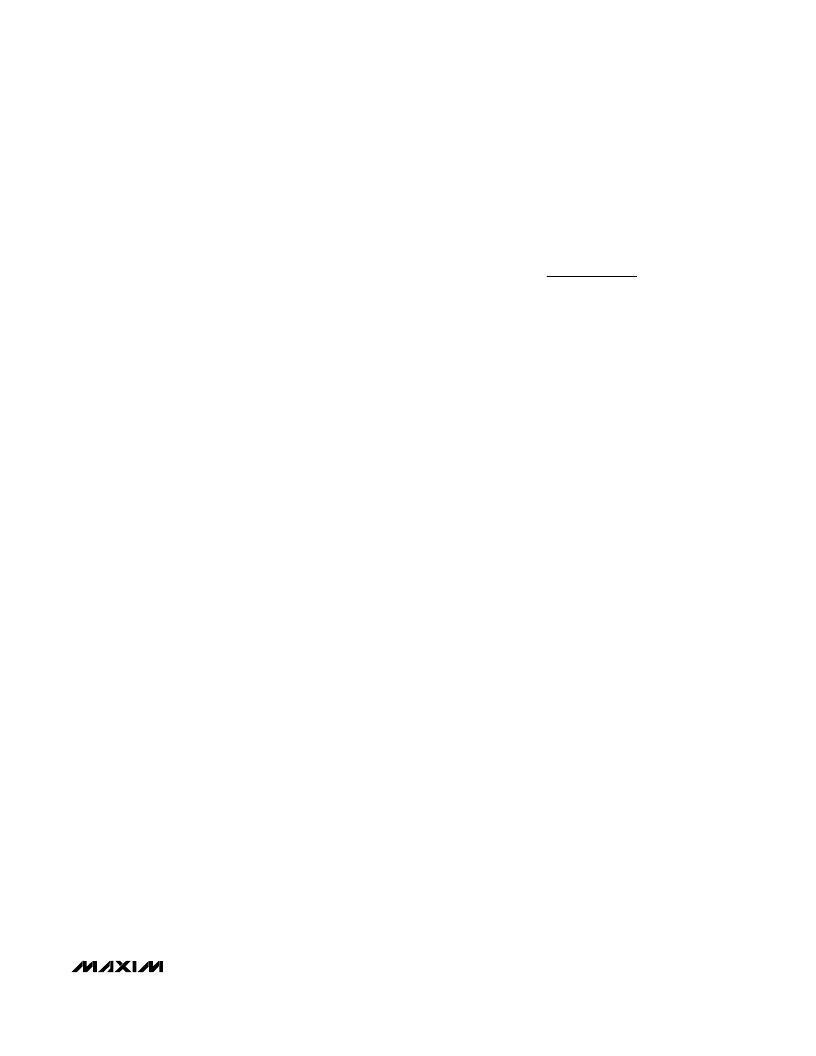- 您現(xiàn)在的位置:買賣IC網(wǎng) > PDF目錄383336 > MAX1800 (Maxim Integrated Products, Inc.) Digital Camera Step-Up Power Supply PDF資料下載
參數(shù)資料
| 型號: | MAX1800 |
| 廠商: | Maxim Integrated Products, Inc. |
| 英文描述: | Digital Camera Step-Up Power Supply |
| 中文描述: | 數(shù)碼相機升壓型電源 |
| 文件頁數(shù): | 15/24頁 |
| 文件大?。?/td> | 461K |
| 代理商: | MAX1800 |

M
Digital Camera Step-Up
Power Supply
______________________________________________________________________________________
15
input source so that high-frequency switching currents
do not pass through the input source.
The output capacitor is required to keep the output volt-
age ripple small and to ensure stability of the regulation
control loop. The output capacitor must have low
impedance at the switching frequency. Tantalum and
ceramic capacitors are good choices. Tantalum capac-
itors typically have high capacitance and medium-to-
low equivalent series resistance (ESR) so that ESR
dominates the impedance at the switching frequency.
In turn, the output ripple is approximately:
V
RIPPLE
≈
I
L(PEAK)
ESR
where I
L(PEAK)
is the peak inductor current.
Ceramic capacitors typically have lower ESR than tan-
talum capacitors, but with relatively small capacitance
that dominates the impedance at the switching fre-
quency. In turn, the output ripple is approximately:
V
RIPPLE
≈
I
L(PEAK)
Z
C
where I
L(PEAK)
is the peak inductor current, and Z
C
≈
1 / (2
π
f
OSC
C
OUT
).
See the
Compensation Design
section for a discussion
of the influence of output capacitance and ESR on reg-
ulation control loop stability.
The capacitor voltage rating must exceed the maximum
applied capacitor voltage. For most tantalum capaci-
tors, manufacturers suggest derating the capacitor by
applying no more than 70% of the rated voltage to the
capacitor. Ceramic capacitors are typically used up to
the voltage rating of the capacitor. Consult the manu-
facturer
’
s specifications for proper capacitor derating.
MOSFET Selection
The MAX1800 auxiliary controllers drive an external
logic-level N-channel MOSFET as the circuit switch ele-
ment. The key selection parameters are:
On-resistance (R
DS(ON)
)
Maximum drain-to-source voltage (V
DS(MAX)
)
Total gate charge (Q
g
)
Reverse transfer capacitance (C
RSS
)
Since the external gate drive swings between POUT
and GND, use a MOSFET whose
“
on
”
resistance is
specified at or below the main output voltage. The gate
charge, Q
g
, includes all capacitance associated with
gate charging and helps to predict the transition time
required to drive the MOSFET between on and off
states. The power dissipated in the MOSFET is due to
on-resistance and transition losses. The on-resistance
loss is:
P
1
≈
D I
L
2
R
DS(ON)
where D is the duty cycle, I
L
is the average inductor
current, and R
DS(ON)
is the on-resistance of the MOS-
FET. The transition loss is approximately:
where V
OUT
is the output voltage, I
L
is the average
inductor current, f
OSC
is the converter switching fre-
quency, and t
T
is the transition time. The transition time
is approximately Q
g
/ I
G
, where Q
g
is the total gate
charge, and I
G
is the gate drive current (typically 0.5A).
The total power dissipation in the MOSFET is:
P
MOSFET
= P
1
+ P
2
Diode Selection
For low-output-voltage applications, use a Schottky
diode to rectify the output voltage because of the
diode
’
s low forward voltage and fast recovery time.
Schottky diodes exhibit significant leakage current at
high reverse voltages and high temperatures. Thus, for
high-voltage, high-temperature applications, use ultra-
fast junction rectifiers.
Compensation Design
Each DC/DC converter has an internal transconduc-
tance error amplifier whose output is used to compen-
sate the control loop. Typically, a series resistor and
capacitor are inserted from COMP_ to GND to form a
pole-zero pair. The external inductor, the output capac-
itor, the compensation resistor and capacitor, and the
POUT-to-OUT RC filter govern control-loop stability.
The inductor and output capacitor are usually chosen
in consideration of performance, size, and cost, but the
compensation resistor and capacitor and the POUT-to-
OUT RC filter are chosen to optimize control-loop sta-
bility. The component values in the circuit of Figure 1
yield stable operation over a broad range of input/out-
put voltages and converter switching frequencies.
Follow the procedures below for optimal compensation.
Main Controller
The main converter uses current mode to regulate the
main output voltage, thereby simplifying the control-
loop compensation. When the converter operates with
continuous inductor current, a right-half-plane zero
appears in the loop-gain frequency response. To
ensure stability, the control loop must cross over (drop
below unity gain) at a frequency much less than that of
the right-half-plane zero.
P
V
3
OUT L OSC T
2
≈
相關(guān)PDF資料 |
PDF描述 |
|---|---|
| MAX1806 | 3A Fixed Low Dropout Linear Regulator (LDO) |
| MAX1806EUA | 3A Fixed Low Dropout Linear Regulator (LDO) |
| MAX1806EUA08 | 3A Fixed Low Dropout Linear Regulator (LDO) |
| MAX1806EUA15 | 3A Fixed Low Dropout Linear Regulator (LDO) |
| MAX1806EUA18 | 3A Fixed Low Dropout Linear Regulator (LDO) |
相關(guān)代理商/技術(shù)參數(shù) |
參數(shù)描述 |
|---|---|
| MAX1800EHJ | 功能描述:直流/直流開關(guān)轉(zhuǎn)換器 RoHS:否 制造商:STMicroelectronics 最大輸入電壓:4.5 V 開關(guān)頻率:1.5 MHz 輸出電壓:4.6 V 輸出電流:250 mA 輸出端數(shù)量:2 最大工作溫度:+ 85 C 安裝風格:SMD/SMT |
| MAX1800EHJ-T | 功能描述:直流/直流開關(guān)轉(zhuǎn)換器 RoHS:否 制造商:STMicroelectronics 最大輸入電壓:4.5 V 開關(guān)頻率:1.5 MHz 輸出電壓:4.6 V 輸出電流:250 mA 輸出端數(shù)量:2 最大工作溫度:+ 85 C 安裝風格:SMD/SMT |
| MAX1800EVKIT | 功能描述:電源管理IC開發(fā)工具 RoHS:否 制造商:Maxim Integrated 產(chǎn)品:Evaluation Kits 類型:Battery Management 工具用于評估:MAX17710GB 輸入電壓: 輸出電壓:1.8 V |
| MAX1801EKA | 制造商:Maxim Integrated Products 功能描述:DIGITAL CAMERA STEP-UP SLAVE DC-DC - Rail/Tube |
| MAX1801EKA+ | 制造商:Maxim Integrated Products 功能描述:DC DC CNTRLR SGL-OUT STEP UP 2.7V TO 5.5V 8PIN SOT-23 - Rail/Tube |
發(fā)布緊急采購,3分鐘左右您將得到回復。